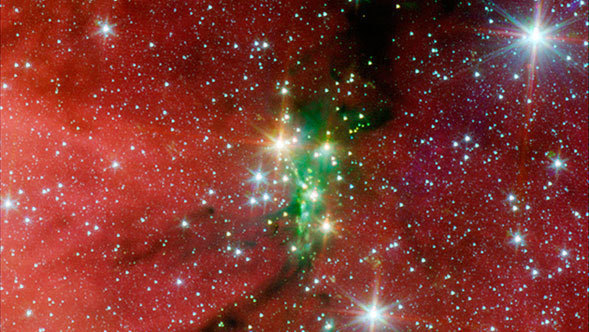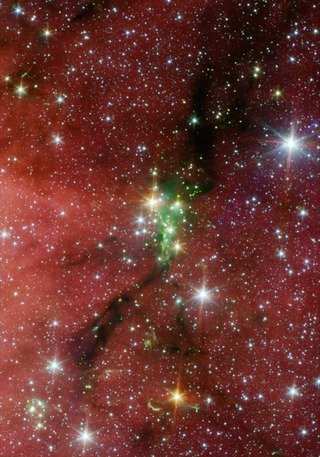
News Release • August 8th, 2007 • feature07-10 •
Written by Linda Vu
Spitzer Science Center
A spectacular new image from NASA's Spitzer Space Telescope uncovers a small group of young stellar "siblings" in the southern portion of the Serpens cloud, located approximately 848 light-years away from Earth. Scientists suspect that this discovery will lead them to more clues about how these cosmic families -- which contain hundreds of gravitationally bound stars -- form and interact.
"It's amazing how these stars really stand out in the Spitzer images. At visible wavelengths the stars can't be seen at all -- they are completely obscured by the dust in the cloud," says Dr. Robert Gutermuth, of the Harvard-Smithsonian Center for Astrophysics. "This is the first time that anyone has ever seen these stars."
The astronomers dubbed this new family "Serpens South."
Forming a Stellar Unit
For years, astronomers have debated how members of large stellar families -- which can contain hundreds of stars -- are related. Some astronomers suspect that the stars may be "fraternal siblings" -- born at the same time from the same "parent" cloud of gas and dust. Meanwhile, other scientists suspect that these stellar family members are "adopted" -- meaning the stars are born in small batches of a few at a time, and eventually many of these small stellar groups will bond to form a massive star cluster, or family.
According to Dr. Lori Allen, also of the Harvard-Smithsonian Center for Astrophysics, one of the greatest challenges in determining how a cluster's stars are related is finding the smaller, younger star clusters in the first place.
"Spitzer is currently the only telescope with the capabilities to find young star clusters like Serpens South, which are deeply embedded inside giant cosmic clouds of gas and dust," says Allen.
Once the small stellar groups are discovered, scientists must figure out whether they are forming a new "family unit," or are members of an established stellar "clan." In the case of Serpens South, Dr. Tyler Bourke, also of the Harvard-Smithsonian Center for Astrophysics, used the Smithsonian's Submillimeter Array (SMA) solve this mystery of stellar ancestry.
From the ground he measured motions of the gas surrounding the newly formed cluster, and determined that the newly discovered stars belonged to the Serpens star-forming cloud, which also hosts the famous and massive Serpens star cluster.
"With the SMA, we were able to show that Serpens South is moving at the same speed as the Serpens Cluster," said Bourke. "It looks like the smaller families are sticking together."
Family Colors
The newly discovered Serpens South stars are shown as green, yellow, and orange specks, sitting atop a black line that runs through the middle of the image. The "line" is a long dense patch of cosmic dust and gas, which is currently condensing to form stars. Like raindrops, stars form when thick cosmic clouds collapse.
Tints of green represent hot hydrogen gas. Spitzer can see this hydrogen gas "fingerprint" when the high-speed jets shooting out of the young stars violently collide with cool gas in the surrounding cloud.
Wisps of red in the background are organic molecules called polycyclic aromatic hydrocarbons (PAHs) that are being excited by stellar radiation from a neighboring star-forming region called W40. On Earth, PAHs are found on charred barbeque grills and in sooty automobile exhaust.
Gutermuth is leading the analysis of the Serpens South Cluster. He is also a member of the Gould's Belt Legacy project, which discovered the Serpens South Cluster, and is using Spitzer's dust-piercing infrared eyes to scour nearby cosmic clouds for small groups of deeply embedded young stars.
"This image provides just a taste of the exciting science that will come from the Gould's Belt Legacy project," says Allen, who is the principal investigator of Spitzer's Gould's Belt Legacy program.





